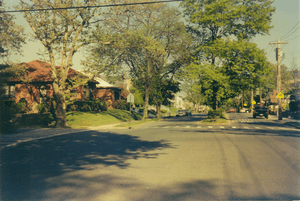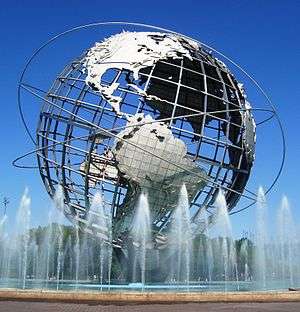Laurelton, Queens
| Laurelton | |
|---|---|
| Neighborhoods of Queens | |
 228th Street at 138th Avenue in Laurelton | |
|
Location within New York City | |
| Coordinates: 40°40′30″N 73°44′42″W / 40.675°N 73.745°WCoordinates: 40°40′30″N 73°44′42″W / 40.675°N 73.745°W | |
| Country |
|
| State |
|
| City |
|
| County/Borough |
|
| Population (2010)[1] | |
| • Total | 24,453 |
| Race/Ethnicity[2] | |
| • Black | 90.1% |
| • White | 1.5 |
| • Asian | 0.7 |
| • Native American | 0.3 |
| • Other | 7.4 |
| ZIP codes | 11413 |
| Area code(s) | 718, 347, 929, and 917 |
Laurelton is a largely middle class neighborhood in the New York City borough of Queens and part of the former town of Jamaica. Merrick Boulevard, which bisects the community in a generally east-west direction, forms its commercial spine. It is bounded by Springfield Boulevard to the west, 121st Avenue to the north, Laurelton Parkway to the east, and Conduit Avenue to the south. The neighborhood is part of Queens Community Board 13. [3] Laurelton's ZIP Codes are 11413 and 11422.
Description
Laurelton derives its name from the Laurelton station on the Long Island Rail Road, which was named for the laurels that grew there over 100 years ago. It was modeled after an English village, with stately Tudor-style homes, both attached and detached. A few co-ops exist in a former garden apartment complex, there has been some new construction but no high-rise buildings, which has enabled Laurelton to keep its small town feel. The area of Laurelton closest to Rosedale and Cambria Heights consists primarily of single-family homes whereas the area abutting Springfield Gardens contains more multi family homes. The area south of Merrick Boulevard contains many large, individually designed houses, while certain blocks to the north, running eastward from Francis Lewis Boulevard, have attached, Tudor-style rowhouses. Laurelton also has a series of streets with planted center malls.[4]
Demographics
In the 1930s through 1970s, Laurelton was home to many Jewish-American families but succeeding generations have included various Afrodescended groups, including African-Americans, Caribbean/West Indians and West Africans, many of whom were attracted to Laurelton's more suburban-like environment. [4][5]
Based on data from the 2010 United States Census, the population of Laurelton was 24,453, a decrease of 1,922 (7.3%) from the 26,375 in 2000. Covering an area of 909.17 acres (367.93 ha), the neighborhood had a population density of 26.9 inhabitants per acre (17,200/sq mi; 6,600/km2).[1]
The racial makeup of the neighborhood was 1.5% (358) White, 90.1% (22,021) African American, 0.3% (69) Native American, 0.7% (167) Asian, 0.0% (4) Pacific Islander, 0.4% (91) from other races, and 1.6% (403) from two or more races. Hispanic or Latino of any race were 5.5% (1,340) of the population.[2]
Private school education
- Cariculum Academy of Southeast Queens A Community Schoolhouse
Transportation
Belt Parkway exits 24A/B, 23A, and 22 service Laurelton. The section of the Belt Parkway known as the Laurelton Parkway was the subject of a master plan[6] as part of the city's emerging system of greenways and bikeways. The restoration of this 1.5 miles (2.4 km) link was completed in 2006.
The Laurelton station on the Long Island Rail Road station, located at 225th Street and 141st Road, offers service via the Far Rockaway and Long Beach branches.
Residents also have access to MTA Regional Bus Operations buses Q5, Q85 and Q77, which connect to New York City Subway stops in Jamaica. The X63 express bus to Manhattan also stops in Laurelton.[7]
Notable residents
- David Bergman (born 1950), gay writer/academic.
- Joel Brind, professor of human biology and endocrinology at Baruch College.[8]
- Sam DeLuca (1936-2011), New York Jets right guard in the 1970s.
- Derrick Harmon (born 1963), NFL running back for the San Francisco 49ers from 1984-1986.[9]
- Ronnie Harmon (born 1964), running back, kick returner who played in the NFL for the Buffalo Bills and San Diego Chargers.[9]
- Marcus Jansen (born 1968), painter.
- Hettie Jones, poet/memoirist and former wife of writer Amiri Baraka.
- Meir Kahane (1932-1990), head of the youth group of the Young Israel of Laurelton; founded the Jewish Defense League.
- Doron Lamb (born 1991), Kentucky Wildcats basketball player.
- Neil Leifer (born 1942), photographer and filmmaker known mainly for his work in the Time Inc. family of magazines.
- Bernard Madoff, former NASDAQ chairman, convicted of the largest financial fraud in U.S. history.[10]
- Irving Mosberg (1908-1973), politician who served in the New York Senate from 1958 to 1967.[11]
- Winston Rodney Reggae music legend, AKA "Burning Spear".
- Elliot Sperling (1951-2017), expert on Tibetan history and the Tibet-China conflict and chair of Central Eurasian Studies at Indiana University
References
- 1 2 Table PL-P5 NTA: Total Population and Persons Per Acre - New York City Neighborhood Tabulation Areas*, 2010, Population Division - New York City Department of City Planning, February 2012. Accessed June 16, 2016.
- 1 2 Table PL-P3A NTA: Total Population by Mutually Exclusive Race and Hispanic Origin - New York City Neighborhood Tabulation Areas*, 2010, Population Division - New York City Department of City Planning, March 29, 2011. Accessed June 14, 2016.
- ↑ Queens Community Boards, New York City. Accessed September 3, 2007.
- 1 2 Beyer, Gregory. "Prosperous Area Seeks Shops to Match", The New York Times, April 24, 2009. Accessed November 2, 2017. "IN parts of Laurelton, Queens, you can look down seemingly endless streets lined with Tudor homes, each a collection of squat rectangles with roofs so pointed as to have come from a child’s drawing.... 'Mine is the eighth-wealthiest district in the city, and a large part of that is Laurelton,' said Councilman James Sanders Jr., of the 31st Council District. “One of the things that make Laurelton unique is that it sits in the only census tract where blacks make more money than whites.'"
- ↑ Roberts, Sam. "Black Incomes Surpass Whites in Queens", The New York Times, October 1, 2006. Accessed November 2, 2017. "In Queens, the median income among black households, nearing $52,000 a year, has surpassed that of whites in 2005, an analysis of new census data shows.... The gains among blacks in Queens, the city’s quintessential middle-class borough, were driven largely by the growth of two-parent families and the successes of immigrants from the West Indies. Many live in tidy homes in verdant enclaves like Cambria Heights, Rosedale and Laurelton, just west of the Cross Island Parkway and the border with Nassau County."
- ↑ "Archived copy" (PDF). Archived from the original (PDF) on 2011-07-21. Retrieved 2009-12-06.
- ↑ "Queens Bus Map" (PDF). Metropolitan Transportation Authority. December 2017. Retrieved April 24, 2018.
- ↑ Yeoman, Barry. "The scientist who hated abortion; Endocrinologist Joel Brind says research has shown him the truth about abortion, and that's why he set out on a crusade that now reaches into the heart of the nation's most powerful cancer agency. But what if he's wrong?", Discover (magazine), February 1, 2003. Accessed November 2, 2017. "Joel Brind was a 10-year-old growing up in Laurelton, New York, when he realized he wanted to become a cancer researcher."
- 1 2 https://www.nytimes.com/1984/10/10/sports/at-iowa-harmon-makes-offense-go.html "At Iowa, Harmon Makes Offense Go"], The New York Times, October 10, 1984. Accessed November 2, 2017. "Greg, 23 years old, is the oldest Harmon brother, followed by Gary, 22, the musically inclined nonathlete of the family, and then Derrick, 21, Ronnie, 20, and Kevin, who will be 19 on Oct. 26.The boys grew up in a two-story brick home in Laurelton, Queens."
- ↑ Segal, David; and Cowan, Alison Leigh. "Madoffs Shared Much; Question Is How Much", The New York Times, January 14, 2009. Accessed February 9, 2009.
- ↑ Staff. "Candidate Picked Here; Queens Democrats Designate Mosberg for State Senate", The New York Times, December 13, 1957. Accessed November 2, 2017. "Mr. Mosberg is 49 years old and lives with his wife and two children at 141-05 228th Street, Laurelton, Queens."
External links
| Wikimedia Commons has media related to Laurelton, Queens. |
